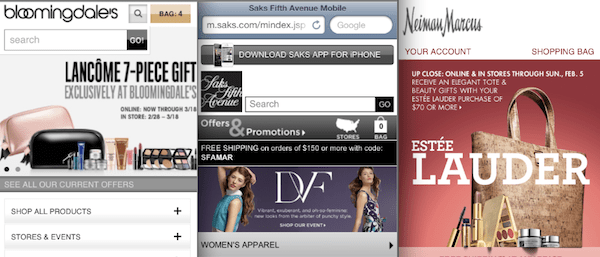
For retailers investing in mobile commerce is a must, but which, if any, is really differentiating itself in the mobile space?
Digiday examined the mobile websites and apps of Neiman Marcus, Bloomingdale’s and Saks, looking at things like layout, user experience and features and functionality. We are taking a broad view of how these three retailers are operating in the mobile landscape.
Neiman Marcus
Mobile site: Let’s start with the fact that when users enter http://www.neimanmarcus.com into their mobile browser, the Neiman Marcus desktop site loads. A simple site redirect would have done the job. To my surprise, I could not even find the Neiman Marcus mobile site, not even through searching Google. I had to do some research and enter http://mobile.usablenet.com/mt/http://www.neimanmarcus.com to access the site. Not good. Once on the site, the user interface is pretty clean and easy to navigate. The in-site search functionality is front and center, making it easy for site visitors to find what they are looking for. However — this is when it gets bad — as I surfed the site, a promotion popped up for free gifts with any $70 purchase from Estee Lauder. The promotion expired on Feb. 5 and can obviously no longer be used. It looks like Neiman Marcus needs to update its mobile site. Furthermore, the product pages don’t load, and the site looks like it’s been abandoned for ages.
App: Neiman Marcus does not have a dedicated mobile application through which consumers can shop, browse and buy. The company does, however, have an app dubbed NM Gifts, meant to help consumers find their loved ones the right gift, in the right price range.
Assessment: Overall, Neiman Marcus’ mobile presence is not up to par. With a site that’s a mess and no mobile application for cultivating loyalists, the luxury retailer has missed the mark with its mobile commerce strategy.
Saks Fifth Avenue
Mobile site: When it comes to the mobile Web, Saks has its strategy on-point. When users enter http://saks.com into their browser, they are automatically redirected to http://m.saks.com. The in-site search functionality is up top, and Saks entices site visitors to buy with an offer for free shipping on orders of $150 or more. There’s also a banner at the top of the page asking site visitors to download the Saks app. The product pages load well and give consumers several product shots, from various angles. Consumers cannot like a product or share it on Twitter. There is also no option to let users share a product via SMS. Saks is really honing in on user behavior with its mobile site, with a section that helps site visitors find current offers and promotions. The layout is clean and easy to navigate. Also, Saks includes a click-to-call option to let consumers connect with customer service and includes an email sign-up form. What’s missing is a call to action asking consumers to opt-in for SMS communications from the brand. Additionally, consumers are not asked to like Saks on Facebook or to start following the retailer on Twitter. A miss on Saks’ part.
App: The Saks mobile app uses a user’s current location to serve relevant content, if the user agrees. Additionally, it sends consumers push notifications, again if they agree. The app is geared towards Saks’ more loyal customers, offering users access to up to 70 percent off of online purchases. When you think about a person who is willing to download a branded app, this mobile user is more loyal than someone who is going to just visit a branded website. Cultivating these loyalists and making them feel special through deals and exclusive offers is the way to approach it. Saks does just that with its mobile app, making it a win in my book. The user interface is clean, easy to navigate and loads quickly.
Assessment: Saks clearly understands the importance of a mobile strategy. Its mobile site and app are evidence of this. Consumers have little patience for waiting in a brick-and-mortar store and even less when it comes to mobile. The fact that Saks’ site and app performance is flawless definitely works in the company’s favor. Consumers who are frustrated by a branded experience on mobile almost always move on to find what they need from someone else, maybe a competitor.
Bloomingdale’s
Mobile site: Upon entering http://bloomingdales.com into my mobile phone’s browser, I was conveniently brought to http://m.bloomingdales.com. Right away, I was offered a Lancome seven-piece gift set and the option of viewing all of Bloomingdale’s current offers. There is no mention of the Bloomingdale’s mobile app on the mobile website, which could help the retailer drive app downloads. Besides having consumers opt in for email communications from Bloomingdale’s, the retailer asks consumers to tap to like it on Facebok and start following it on Twitter. This helps Bloomingdale’s segment its loyalists from the random, once-in-a-blue-moon shoppers. The site loads extremely fast, and the layout is clean and easy to navigate. Bloomingdale’s product pages are my absolute favorite, giving consumers the option to read and write reviews, and share a specific product via Facebook, Twitter or email. The only thing missing is a feature that lets consumers share products via SMS. The Bloomingdale’s mobile site is quite advanced in terms of features and functionality when compared to the Neiman Marcus and Saks sites.
App: Bloomingdale’s also has a mobile app. It’s a way for its most loyal customers to unlock a world of exclusive must-haves. The app loads quickly, and its design and layout make it easy to navigate. It uses push notifications to alert users on things that are happening at Bloomingdale’s. What’s weird is that app is not shoppable, meaning consumers can’t actually buy anything through it. Instead, it features a map of Bloomingdale’s, different places to eat near its flagship store on 59th St., and the ability for users to create wishlists. Overall, the app isn’t as good as Saks’, because it does not let people buy.
Assessment: Bloomingdale’s has a well-thought-out mobile strategy. Its execution is better than Neiman Marcus’, to say the least. Bloomingdale’s understands the behaviors of today’s mobile-enabled consumers, as evidenced by its mobile site’s social functionalities. The fact that the retailer connects consumers to its social media destinations via the mobile site will only work in Bloomingdale’s favor. Additionally, the ability for users to share specific products they like via Facebook, Twitter and email also shows how Bloomingdale’s is ahead of the game in mobile commerce. But, the fact that the Bloomingdale’s mobile app is not commerce-enabled is not a good thing. Bloomingdale’s could be driving additional sales through its app if consumers could buy through it.
Conclusion
Bloomingdale’s is the clear winner when it comes to the mobile Web. However, it lacks in its app strategy. On the other hand, Saks’ mobile website, while good, is not as good as http://m.bloomingdales.com. But, Saks’ mobile app is superior to the Bloomingdale’s app. Neiman Marcus’ mobile presence is a disappointment: The company has no mobile app, and its mobile website is a terribly painful experience.
More in Media

BuzzFeed’s sale of First We Feast seen as a ‘good sign’ for the M&A media market
Investor analysts are describing BuzzFeed’s sale of First We Feast for $82.5 million as a good sign for the media M&A market — which itself is an indication of how ugly that market had become.

Media Briefing: Efforts to diversify workforces stall for some publishers
A third of the nine publishers that have released workforce demographic reports in the past year haven’t moved the needle on the overall diversity of their companies, according to the annual reports that are tracked by Digiday.

Creators are left wanting more from Spotify’s push to video
The streaming service will have to step up certain features in order to shift people toward video podcasts on its app.





